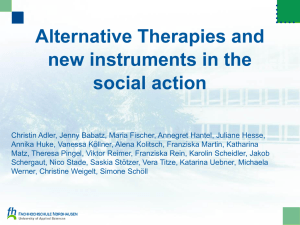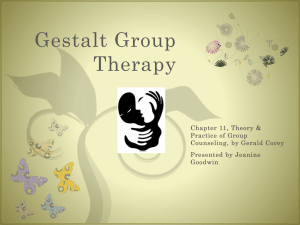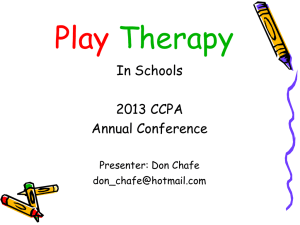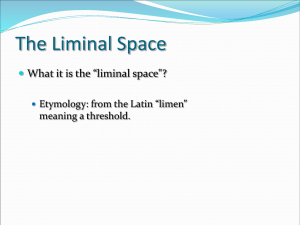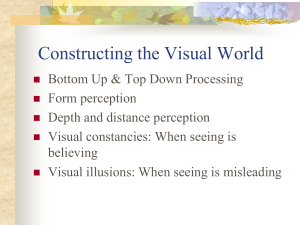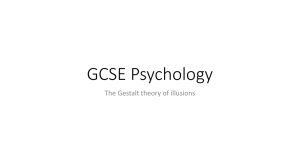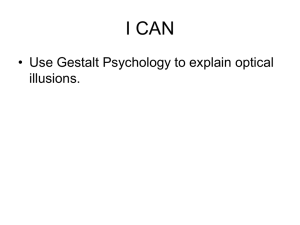the simplest and most stable interpretations are favored
advertisement
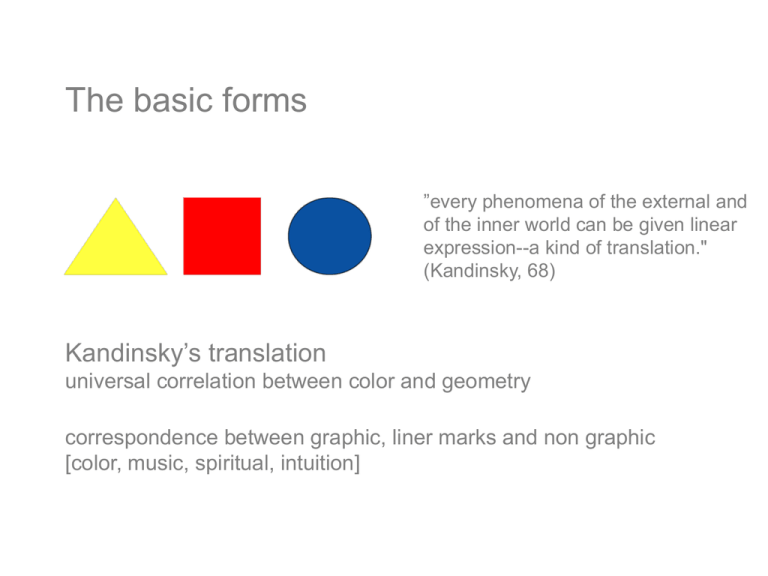
The basic forms ”every phenomena of the external and of the inner world can be given linear expression--a kind of translation." (Kandinsky, 68) Kandinsky’s translation universal correlation between color and geometry correspondence between graphic, liner marks and non graphic [color, music, spiritual, intuition] The basic forms pictorial composition as system of forces defining a visual language Bauhaus — an attempt to identify language of vision—a code of abstract forms addressed to immediate biological perception rather than culturally conditioned intellect to temporarily isolate visual form from the context of its cultural use theory of polar contrasts visual language as a system of perceptual oppositions Bauhaus Walter Gropius, 1920. Gestalt psychology founded in 1910 by Max Wertheimer, and his students Kurt Koffka and Wolfgang Köhler challenged the notion that visual data is culturally learned the brain spontaneously orders and simplifies sense data into structured, holistic patterns Gestalt in German gestalt means form ,shape “unified physical, psychological, or symbolic configuration Having properties that can not be derived from its parts.” (American Heritage Dictionary) organizational essence of the world holistic pattern seeking a “digestible” whole Gestalt theory images are perceived as a pattern or a whole rather than a sum of the distinctive parts context plays a key role in perception changing the relative size, changes the perceived importance of the elements to each other Gestalt theory changing the relative size, changes the perceived importance of the elements to each other Gestalt theory This is a modern reproduction of the Minoan bull-leaping artwork from 1500 BC uncovered at Knossos. The original 32-inch high fresco is in the Iraklio (or Heraklion) Archaeology Museum Minoan Dolphin Fresco close-up changing the relative size, changes the perceived importance of the elements to each other Gestalt theory Minoan Fresco close-up changing the relative size, changes the perceived importance of the elements to each other Gestalt theory Mary nursing, in a Nativity scene, Omorphi Ekklesia, Aegina, 1282 Fresco. changing the relative size, changes the perceived importance of the elements to each other Gestalt theory the whole is not equal to the sum of its parts. our thoughts and preconceptions shape what we perceive we do not see exactly what is out there—our perceptions are shaped by our thoughts the whole is not equal to the sum of its parts Gestalt Principles of Organization melody is still recognizable when played in different keys, even though none of the notes are the same [Christian von Ehrenfels 1890] belonging together elements that look alike are called similarity grouping elements that are close together are called proximity grouping elements that have structural economy are called good continuation we tend to impose meaning and structure on things we see we make patterns out of chaos design strategies Gestalt theory: Visual Principles figure/ground equilibrium isomorphic correspondence closure/completion/projection proximity continuation similarity Gestalt theory: Visual Principles figure/ground, the simplest and most stable interpretations are favored. an object [form] is differentiated from its surroundings [context, background] the object must peel of its context to see it as a separate form or one can observe changes in relationship to its context if object can not be seen as an organized structure, it can not be separated from its context Gestalt theory: Visual Principles figure/ground ambiguity 50% Gestalt theory: Visual Principles figure/ground, the simplest and most stable interpretations are favored. figure ground and meaning Gestalt theory: Visual Principles equilibrium the simplest and most stable interpretations are favored. every field tends towards order, balance and efficiency also called: law of good configuration or low of pragnänz, simplicity and good figure Gestalt theory: Visual Principles isomorphic Correspondence Specific visual images trigger associations also called: law of familiarity Gestalt theory: Visual Principles proximity features which are close together are associated. Gestalt theory: Visual Principles proximity features which are close together are associated. things close to each other seem to belong together in a group proximity may be spatial proximity may be temporal Gestalt theory: Visual Principles closure interpretations which produce 'closed' rather than 'open' figures are favored. this principle of closure cuts across the principle of proximity natural tendency to close gaps and complete unfinished forms Gestalt theory: Visual Principles closure interpretations which produce 'closed' rather than 'open' figures are favored. ability to fill in information to see parts as a whole to supply missing information Gestalt theory: Visual Principles similarity features which look similar are associated Gestalt theory: Visual Principles continuation contours based on smooth continuity are preferred to abrupt changes of direction. Gestalt theory: Visual Principles continuation contours based on smooth continuity are preferred to abrupt changes of direction. elements that follow a smooth curve, a straight line, or a repetitive pattern tend to be grouped together also called low of common faith Gestalt theory: Visual Principles smallness Smaller areas tend to be seen as figures against a larger backg Gestalt theory: Visual Principles symmetry symmetrical areas tend to be seen as figures against asymmet backgrounds Gestalt theory: Visual Principles surroundedness areas which can be seen as surrounded by others tend to be perceived as figures. laws of visual organization the interplay of grouping tendencies is far from simple: (1) the effect of simultaneous contrast demonstrates that the appearance of parts is determined by wholes; (2) judgments about similarity or proximity are always comparative; (3) in compositions as intricate as paintings, posters and page layouts, parts may be purposely made to connect by one grouping tendency (similarity of color, for example) but to disconnect by others (distance, for example, or differences of shape, size or direction laws of visual organization the parts of an image can be perceived as distinct components, but the whole is greater than—and different from—the sum of its parts.... Patterns are more important visually then their component parts a collection of individual visual elements communicate a gestalt which is a message held together by design, while separately the elements may be meaningless Color relativity Josef Albers Interaction of color Study the gray in the center of one pair of complements at the same time. What differences can you see? http://www.rotorbrain.com/foote/interactive/hacks/co Color relativity Color relativity Color relativity Ground subtraction: two colors as one http://www.rotorbrain.com/foote/interactive/hacks/colorinteraction1.html Color relativity Color relativity Color relativity Ground subtraction: two colors as one Ground subtraction: two colors as one Effect of Contrast on Perception of Color Difference Bartleson-Breneman Effect Transparence and Space Vibrating Boundaries
